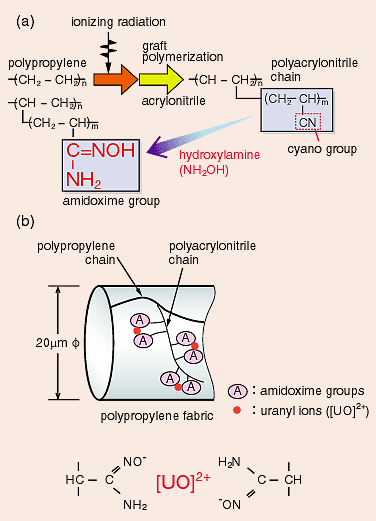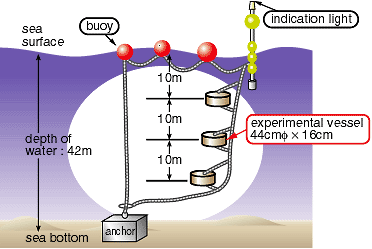 |
|||||||||
|
|||||||||
 |
|||||
|
|||||
| Seawater is known to contain various kinds of elements, such as
uranium, vanadium, cobalt, as well as sodium, magnesium, and so
on. Uranium is dissolved in the ratio of about 3.3 mg per 1 ton
seawater. The total amount of uranium dissolved in all the earth's
seawater can be assumed to be more than 4 billion tons. If it
were possible to selectively collect the uranium dissolved in
the sea, an inexhaustible resource of uranium could be established.
By using a radiation grafting technique, we developed a polymer material to be used as the adsorbent for these elements which are dissolved in trace concentrations in seawater. The adsorbent, which consists of the grafted nonwoven fabrics of polypropylene, was found to effectively adsorb the valuable elements, such as uranium, cobalt, and vanadium, with a high selectivity. Nonwoven fabrics are irradiated with ionizing radiation and grafted with acrylonitrile monomers. Then, the grafted fabrics are immersed in the hydroxyl amine solution to convert the cyano groups on the graft chains into amidoxime groups. The amidoxime groups can selectively adsorb uranium from uranyl carbonate to form a complex compound. The adsorbent thus obtained was packed in wire-mesh vessels, through which seawater can easily flow, and these vessels were immersed in the sea at a depth of 40-45 m at a temperature of about 20 degrees for 20 days. The adsorbent was found to be able to collect uranium in the ratio of 1 g uranium to 1 kg adsorbent. What this means is that the adsorbent developed here is very promising in practical terms for the collection of uranium from the sea. |
| Reference T. Sugo, Status of Development for Recovery Technology of Uranium from Seawater, Nippon Kaisui Gakkai-Shi, 51 (1), 20 (1997). |
| Select a topic in left column |
|
Persistent Quest-Research Activities 1998 Copyright(c)Japan Atomic Energy Research Institute |